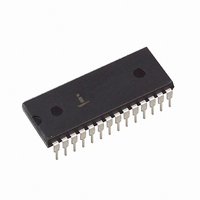ICL7135CPIZ Intersil, ICL7135CPIZ Datasheet - Page 6

ICL7135CPIZ
Manufacturer Part Number
ICL7135CPIZ
Description
IC ADC 4.5DIGIT MUXED BCD 28DIP
Manufacturer
Intersil
Datasheet
1.ICL7135CPIZ.pdf
(15 pages)
Specifications of ICL7135CPIZ
Display Type
LED, LCD
Configuration
7 Segment
Interface
BCD
Digits Or Characters
A/D 4.5 Digits
Current - Supply
1.1mA
Voltage - Supply
4 V ~ 6 V
Operating Temperature
0°C ~ 70°C
Mounting Type
Through Hole
Package / Case
28-DIP (0.600", 15.24mm)
Lead Free Status / RoHS Status
Lead free / RoHS Compliant
Available stocks
Company
Part Number
Manufacturer
Quantity
Price
Company:
Part Number:
ICL7135CPIZ
Manufacturer:
TI
Quantity:
12 400
Company:
Part Number:
ICL7135CPIZ
Manufacturer:
INTERSIL
Quantity:
28 314
Part Number:
ICL7135CPIZ
Manufacturer:
INTERSIL
Quantity:
20 000
Digital Section
Figure 5 shows the Digital Section of the ICL7135. The
ICL7135 includes several pins which allow it to operate
conveniently in more sophisticated systems. These include:
Run/HOLD (Pin 25)
When high (or open) the A/D will free-run with equally
spaced measurement cycles every 40,002 clock pulses. If
taken low, the converter will continue the full measurement
cycle that it is doing and then hold this reading as long as
R/H is held low. A short positive pulse (greater than 300ns)
will now initiate a new measurement cycle, beginning with
between 1 and 10,001 counts of auto zero. If the pulse
occurs before the full measurement cycle (40,002 counts) is
completed, it will not be recognized and the converter will
simply complete the measurement it is doing. An external
indication that a full measurement cycle has been completed
is that the first strobe pulse (see below) will occur 101 counts
after the end of this cycle. Thus, if Run/HOLD is low and has
been low for at least 101 counts, the converter is holding and
ready to start a new measurement when pulsed high.
STROBE (Pin 26)
This is a negative going output pulse that aids in transferring
the BCD data to external latches, UARTs, or
microprocessors. There are 5 negative going STROBE
pulses that occur in the center of each of the digit drive
pulses and occur once and only once for each measurement
cycle starting 101 clock pulses after the end of the full
measurement cycle. Digit 5 (MSD) goes high at the end of
the measurement cycle and stays on for 201 counts. In the
center of this digit pulse (to avoid race conditions between
changing BCD and digit drives) the first STROBE pulse goes
negative for
4 goes high (for 200 clock pulses) and 100 pulses later the
STROBE goes negative for the second time. This continues
through digit 1 (LSD) when the fifth and last STROBE pulse
is sent. The digit drive will continue to scan (unless the
1
/
2
clock pulse width. Similarly, after digit 5, digit
ANALOG
SECTION
CROSS.
ZERO
DET.
6
V
POLARITY
11
DIGITAL
+
GND
FF
POLARITY
FIGURE 5. DIGITAL SECTION OF THE ICL7135
24
23
CLOCK
IN
LATCH
22
HOLD
RUN/
D5
MSB
25
12
ICL7135
LATCH
RANGE RANGE
OVER
D4
CONTROL LOGIC
27
17
COUNTERS
LATCH
MULTIPLEXER
previous signal was overrange) but no additional STROBE
pulses will be sent until a new measurement is available.
BUSY (Pin 21)
BUSY goes high at the beginning of signal integrate and
stays high until the first clock pulse after zero crossing (or
after end of measurement in the case of an overrange). The
internal latches are enabled (i.e., loaded) during the first
clock pulse after busy and are latched at the end of this clock
pulse. The circuit automatically reverts to auto-zero when
not BUSY, so it may also be considered a (Zl + AZ) signal. A
very simple means for transmitting the data down a single
wire pair from a remote location would be to AND BUSY with
clock and subtract 10,001 counts from the number of pulses
received - as mentioned previously there is one “NO-count”
pulse in each reference integrate cycle.
OVERRANGE (Pin 27)
This pin goes positive when the input signal exceeds the
range (20,000) of the converter. The output F/F is set at the
end of BUSY and is reset to zero at the beginning of
reference integrate in the next measurement cycle.
UNDERRANGE (Pin 28)
This pin goes positive when the reading is 9% of range or
less. The output F/F is set at the end of BUSY (if the new
reading is 1800 or less) and is reset at the beginning of
signal integrate of the next reading.
POLARlTY (Pin 23)
This pin is positive for a positive input signal. It is valid even
for a zero reading. In other words, +0000 means the signal is
positive but less than the least significant bit. The converter
can be used as a null detector by forcing equal frequency of
(+) and (-) readings. The null at this point should be less than
0.1 LSB. This output becomes valid at the beginning of
reference integrate and remains correct until it is revalidated
for the next measurement.
UNDER
D3
28
18
STROBE
LATCH
D2
26
19
BUSY
D1
LATCH
21
LSB
20
13
14
15
16
B1
B2
B4
B8
FN3093.4












